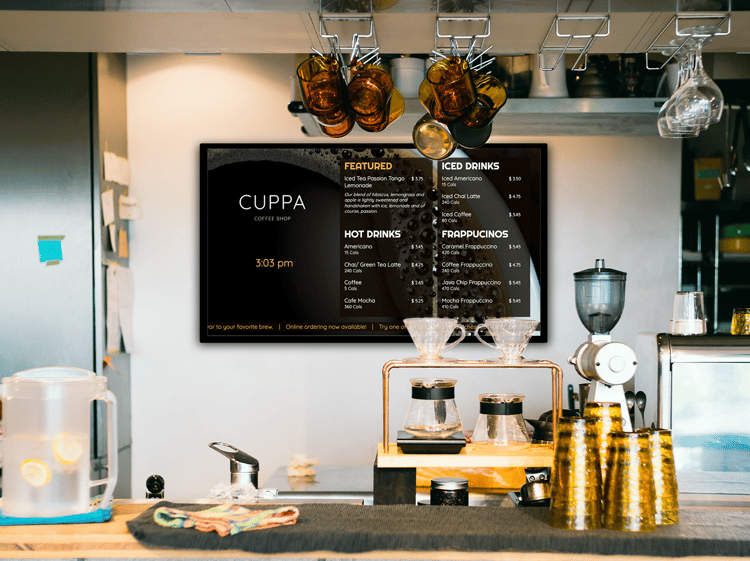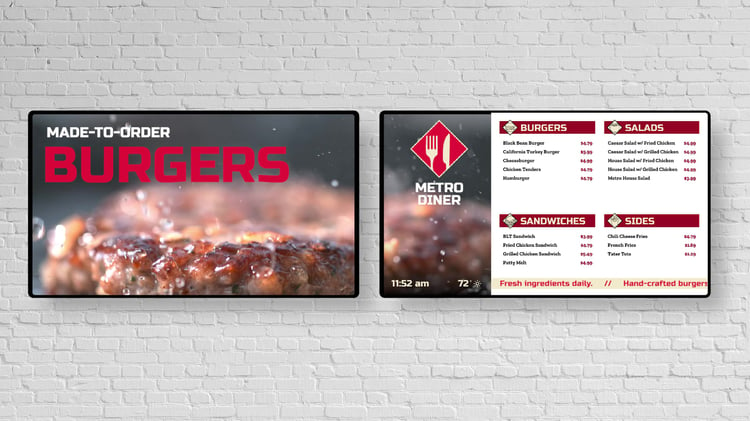If you have digital signage, you’ve undoubtedly worked hard to make it look amazing. The content displayed on your screens is appealing and eye-catching, and would make anyone drool (even you!).
However, have you optimized your signage not just for the content that shows up on the screens, but also for the physical space it occupies?
Where and how you hang your screens matters a lot! In fact, the location, orientation, and spatial elements of your digital signage can determine whether or not your customers even see your beautiful, vibrant content in the first place.
Keep reading for six tips on how to make your digital signage the center of attention by mounting it the right way (plus, some tips on what to avoid).
Consider your space’s layout and accessibility.
This first point may seem obvious, but physical requirements might limit the placement of your digital signage in the space you have to work with. That means it’s vital you start by asking questions about your preferred locations and considering their ease of access.
For example, are walls available to your operation? What about floor space, or even your ceilings? Do you have potential countertop space near a register or station? How about placing your digital signage outdoors?
You also have to take into account environmental elements before you install your screens, both indoors and out. These elements include things like glare, heat/humidity, and proximity to threats (such as branches whipping around in the wind and potentially breaking the screen).
Of course, wherever you want to put your signage, make sure your staff and technical team can easily access the screens, even if they need to use tools like a stepladder. No one should significantly struggle to reach or handle your signage in the case of repairs or replacement.
Determine what technical requirements might influence placement.
On a related note, some areas across your location’s space may be better suited for digital signage simply due to technical reasons. Facilities access is just as important to think about as physical access.
Consider how close your preferred screen placement is to an electrical outlet (or not). Will you need to use and disguise any extension cords? And what about your network connection — will the screens be hooked up to Ethernet cables or will they operate off of your WiFi?
Other technical requirements may come into play here, too. For example, building code requirements or outdoor restrictions may dictate where you can place your screens. Make sure you know what these rules are before mounting any hardware.

Let the purchasing process inform placement.
Based on your available options, the next thing you should consider when mounting your screens is where they will most benefit your customers. In fact, the most effective digital signage is the kind that caters to the customer’s purchasing process.
What is the purchasing process? In short, it’s part of the journey customers go through when interacting with your brand. And signage can help customers as they choose options and purchase food from your operation.
This means that, at minimum, your screens should be near food items and stations, before customers reach the checkout. You may also find it’s useful to have a screen near your entry area, too. Overall, your digital signage should be in locations that make the purchasing process as delightful and informative for customers as possible.
Take into account customers’ viewing distance.
Now that you’ve picked the ideal locations for your digital signage, what else can you do to make sure your digital signage maximizes the customer experience? For starters, think about the size of screens you’ll want to use based on audience viewing distance, as well as your budget.
For example, here at Nutrislice, we have a range of screen sizes available, but they all differ in how far away a guest can stand and still read/understand them. Here’s a breakdown of some of these screens and their coordinating viewing distances:
- 32" is the smallest available: 4-foot viewing distance
- 43" is the smallest we typically recommend: 6-foot viewing distance
- 55" is a common size: 7.5-foot viewing distance
- 65": 9-foot viewing distance
- 75": 11-foot viewing distance
As you consider the physical distance your digital signage will be from your guests, keep in mind your budget, as well. Larger screens tend to cost more in terms of purchasing and installation, so what you can afford also plays a factor in where your screens can be mounted (i.e. if you have a mid-range budget, you’ll have to place your screens closer to customers’ viewing ranges).

Utilize multiple monitors where appropriate.
One of the benefits of digital signage is that you’re not limited to one screen only. In fact, depending on your space’s layout and access points, you can put multiple monitors next to each other to imitate one larger screen full of that beautiful content you worked so hard to create.
Of course, multiple monitors won’t work for every space or use case. For example, it may not be a good idea to have two floor-standing signage placed side-by-side. Not only does this take up a lot of space, but floor-standing screens are best utilized solo to show rotating menu or marketing information to guests as they enter your operation.
However, if you have space on your walls, you could consider placing 2-3 screens next to each other so your presentations and content can “connect” seamlessly across all of them. This is an excellent solution for empty walls approaching your counter so you can display your full menu and nutrition information in one area.
Use the right angles and orientation for your digital signage.
Last but not least, make sure you orient your digital signage the right way for the space it’s occupying. It seems obvious, but your screens’ orientation, articulation, and tilt angle can enhance the customer’s overall experience with your brand and make it easier to communicate your menus and messages.
When you look at potential mounting locations for your digital signage, is it a taller space (better for vertical mounting) or a wider space (for a horizontal layout)? Do you want to have multiple monitors side-by-side that won’t fit unless you orient them a specific way?
What about the articulation and angle of your screens? Does the digital signage need to tilt down for reduced glare and better viewing? Overall, what orientation and tilt simply look best when you take a step back and look at the screens?
These questions and more can help you determine whether or not your screens should be mounted vertically or horizontally, as well as what angles they should use during and after installation.

Remember, if you want your digital signage to be as effective as possible, creating beautiful content for the screens isn’t enough. You should also strategically think about how your signage will be placed or mounted in your location’s physical space to maximize its impact and create a positive, lasting impression on your guests.
So how are you going to start hanging?
Need other ideas for how to make your digital signage valuable to your customers? Check out this post on how you can do just that!
